 |
|
Miracle Pictographs
|
June 2012
When You Play The Game of Cookies, You Win Or You Have No Cookies.
A Game of Thrones: The Graphic Novel, Volume One (Bantam Books, 2012),
Nextwave: Ultimate Edition (Marvel 2006)
Apologies for the many tears that poured through a Miracle Pictographless May.
Life comes at you fast sometimes, like a thousand armadillos falling off a cliff.
Luckily, like the armadillos, I wear a suit of scaly armor and I'm only bruised in
my darkest armadillo heart.
So, unless you live under a nice cozy, gooey rock, with earthworms and slugs and
no danger save centipedes and maybe a persistent armadillo, you've heard of
George R.R. Martin's Song of Ice And Fire books, known in their TV incarnation
as Game of Thrones.
(If you do live under a rock, tell those stupid slugs to stop eating my kale!)
There are two things I like to riff on in this column: the low availability of fantasy
comics, barring the long-running and legendary ElfQuest and Bone, and the
generally poor quality of comic-book adaptations. The great exception to both thus
far has been the Dark Tower comics by Peter David and Jae Lee, which paired the
unique language of Stephen King's Mid-World with highly stylized, dark and
wrenching art.
I had high hopes for A Game of Thrones as well, since it's written by Daniel
Abraham, a fantastic fantasy and comic book writer in his own write. (Yes, I did
that on purpose.) One of the problems with adapting books into comics is that the
comics often run out of space to represent the massive amount of material in the
books, or the ratio of captions and inner dialogue to actual dialogue feels too far
from a comic.
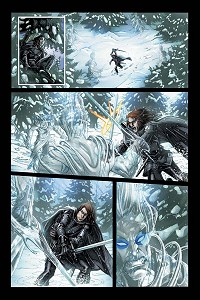
Abraham does a good job of negotiating both issues. You never feel that there are
too many words on the page, and the scenes flow with a skillful cinematic flair --
in many cases, better than they do HBO's screen. Abraham does use a lot of
Martin's words in the captions, and it is a bit odd to see third-person past-tense in
the captions when comic readers are used to first-person present-tense . . . but it
works. The entire adaptation flows.
Truly, Abraham understands the strengths of Martin's work better than David
Benioff and Dan Weiss, HBO's showrunners.
Oh, I know the show is a rather magnificent piece of TV -- but does anyone else
feel it succeeds in spite of Benioff and Weiss's attempts to ruin Martin?
For example, a crucial step in the character of Daenerys Targaryen is well-represented in the graphic novel, where it was butchered in the TV show. In
Martin's original novel, Daenerys is sold to Khal Drogo, the Ghengis Khan-type
warlord whose army of horsemen will supposedly help the exiled Targaryens take
back their throne.
(Jeez, you can't even talk about these books without a few thousand words.)
Daniel Abraham here follows Martin's story with the intimate portrait of Daenerys
and Drogo's wedding night. While Dany cannot be said to be anything but a
possession, in both Martin's novel and Abraham's graphic novel, Drogo gently
removes her clothes and hesitates, speaking the only word he knows in her tongue:
"No?"
Dany has thus far been a possession, sold, bartered for, disrespected -- but Drogo
allows her a degree of agency that begins a mutual respect between the two. He
will not force her sexually. The scene ends when Dany says "Yes."
In the TV show, however, Drogo simply bends Dany over and rapes her, his "No"
much more of an order. It's a massive departure from the mood of the wedding
night in Martin's novel, and it has been a detraction from Dany's character arc in
the show ever since.
Regular watchers of the TV show all recognize that the episodes Martin pens
himself are a cut above the rest of the season. Plot twists that alter the book, like
Robb's current HBO romance, are a distraction from better-motivated actions in
the story. The show is cluttered with some extra scenes, including the required
gratuitous nudity.
While the graphic novel makes no concessions about the nudity and violence, it's
all canonical, and does not distract from the story the way the show's "Now to the
whorehouse!" scenes do.
And in a move that the show can't help, the graphic novel is able to show us
Martin's world without budgetary constraints. The king's retinue that pours
through the gates of comic-book Winterfell is every bit as lavish as Martin's
fifteenth-century-esque descriptions made it. The clothes, the costumes, the castles,
the wolves . . . the whole graphic world is rich and deep in a way the HBO series
couldn't do without quadrupling its budget.
However, the actual people are a problem.
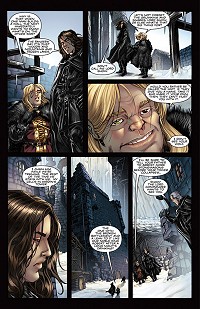
Tommy Patterson is no household name in comics. This is his most high-profile art
assignment yet. Daniel Abraham makes the point afterward that they needed to
sign an artist who could both work for a reasonable rate and devote years of his life
to the project.
I have a hard time believing that, unless Bantam's pay rates are really low, they
didn't look at more high-profile artists.
And that's a shame.
Patterson tries. But he's a workhorse asked to do Seabiscuit's job. His people all
look too alike, especially the women. Thirty-something Catelyn Stark, a woman
who has borne five children, has the exact same profile as fifteen-year-old
Daenerys Targaryen. They both look like they were based on the same swimsuit
model.
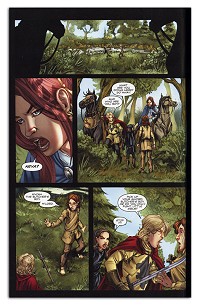
The faces are Patterson's real weak point. They all look far too cartoonish. There is
no difference between the childish frustration on Arya's face and the anger over
her son's death on Catelyn Stark's face.
Patterson does get the tricky profile of Tyrion Lannister right. Dwarfism doesn't
just mean shortness, and he gets the shortened legs versus heightened torso and
head-ratio right. But too often Patterson's figures, actions and faces are
indistinguishable.
It pains me to give Patterson a bad review. His art is really not all that different
than that of some major industry professionals. Mark Bagley of Ultimate Spider-Man comes to mind -- good dynamics, but a bit too rushed and weak in the facial
expressions. Patterson would do well on most superhero books and on some non-mainstream books.
A Game of Thrones is a totally different animal.
Martin's work resonates because it, like Tolkien's, sweeps us up and takes us
somewhere else. The art should do the same, and there are a lot of artists who
could do it -- like Jae Lee of The Dark Tower. They are not cheap, it's true. But
Patterson makes it look too much like a typical comic, and that will be a big
difference in sales to people who don't read comics.
Many better artists are quick. Carlos Pacheco has held down dozens of monthly
gigs as one of the best artists in the biz, and he also created a picture-perfect, detail
rich Great War-era fantasy world in the series Arrowsmith. He could easily
summon all the medieval detail necessary -- and the very real people.
And though Pacheco would be my first choice, Jill Thompson churned out some of
the best of Neil Gaiman's Sandman storyarcs, and she's only gotten better since
she drew the auctioning off of Hell in Season of Mists.
Let us take heart, though. The Dark Tower threw the gauntlet; A Game of Thrones
is not a perfect response, but one hopes that it will open the door to more
adaptations. I see a future not far off where relatively popular fantasy series, like
Jim Butcher's Codex Alera or Glen Cook's Black Company, will get the ongoing-series treatment from artists and writers who can strike the right balance, and
fantasy will start to edge out superheroes in comics.
Of course, when I read Nextwave, I wonder why I ever wanted any other
entertainment.
Can one truly describe Nextwave? No. So instead I'll just write out the words to the
theme song (words and music in the back of the trade paperback):
It's like Shakespeare,
But with lots more punching,
Like Goethe,
But with lots more crunching
Like Titanic,
But the boat's still floating
No it's not,
The mother-****ing boat is exploding!
Nextwave is penned by Warren Ellis, who writes a lot of comics and they are all
twisted and kinky, like a gyrating armadillo. In this case, five also-ran, little-known
Marvel heroes are pushed together for a hilarious send-up of Marvel's typical hero
exploits.
We open on Elsa Bloodstone and The Captain, two of our heroes. Elsa inquires,
"So what was your superhero name?" He responds, "Captain ****." Justifying it,
he goes on, "Hey, I'm from Brooklyn. I'm going to call myself Mr. Friendly? I met
Captain America once. He asked me what my name was. Man, he beat seven
shades of it out of me. Left me in a dumpster with a bar of soap in my mouth."
From there . . . you know what? There is absolutely no point in a plot recap,
because there isn't much plot. Let's just say that our heroes Monica Rambeau,
formerly Captain Marvel and leader of the Avengers (who never gets tired of
reminding people), the Captain, Elsa Bloodstone the Monster Hunter, Aaron Stack
the Machine Man, and Tabby the klepto who can make things explode . . .
Fight.
They fight, among others:
A dragon in purple underpants
Man-eating koalas
Purple Soviet gorilla soldiers
Eye-laser wielding Stephen Hawking clones
Elvis-headed MODOKs and Iron Babies
A giant gorilla with all the power of Wolverine
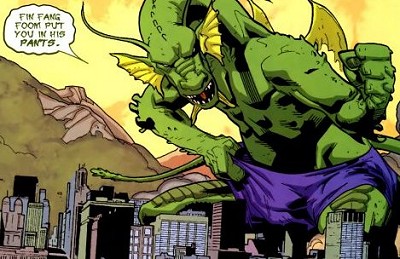
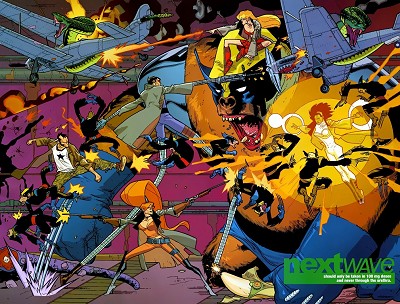
Should I go on?
They are really fighting Dirk Anger and H.A.T.E, a sendup of S.H.I.E.L.D., using
their secret knowledge of Dirk Anger's fetish for his mother's clothes and suicide
wish. But that's beside the point. Plot is not prominent in this comic. Fighting is.
Some of the highlights from this comic: Monica Rambeau recalls what her time
was really like in the Avengers (mostly Captain America telling the ladies to go
back to Avengers Mansion and get started on dinner), any of Tabby's dialogue,
especially as she destroys the home-grown clone soldiers: "I'm sorry, broccoli
murder dudes -- you just grow up to be like too harsh, y'know?", Dirk Anger's
monologue "My cook serves me an entire animal and I fight it bare-handed and
tear off what I want and eat it and have the rest buried in NEW JERSEY!" and
Aaron Stack's repeated refrain "My robot brain needs beer."
Of course no one could better represent such madness than stellar, dynamic, line-work master Stuart Immonen. I'm not going to wax poetic about his work either,
because did you see the list of things they fought and he drew them well damn it!
And for that matter, I think HBO should make a show of Nextwave. Because it
takes "gratuitous" to a hilarious new level.
Next issue: Sequential art! HOLY CRAP!
Read more by Spencer Ellsworth